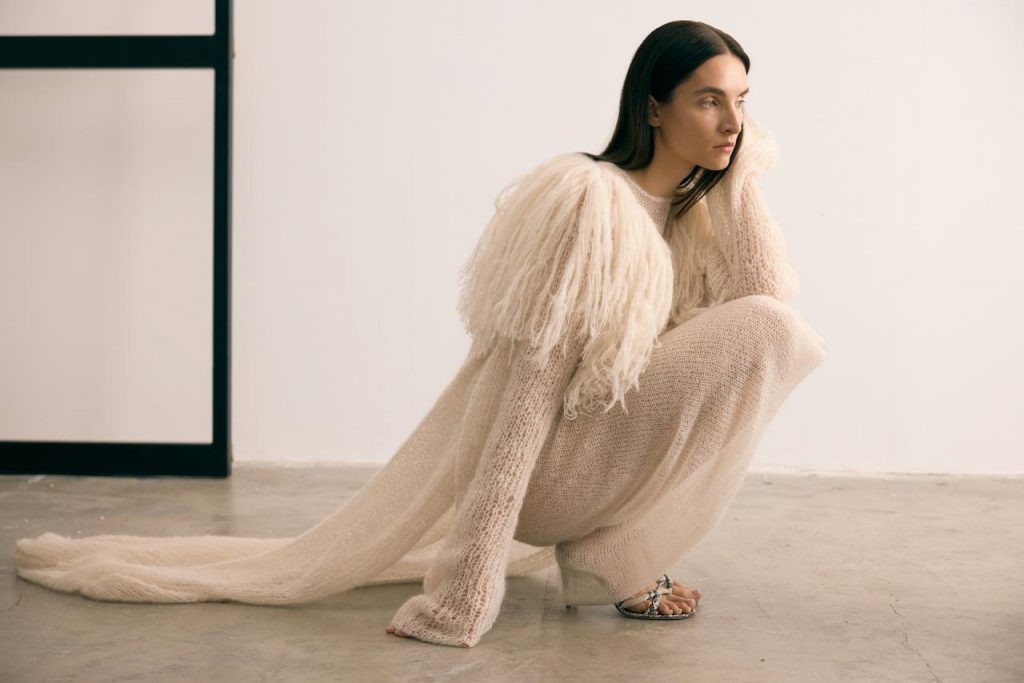The Boho revival in 2025 saw the proliferation of handmade elements like crochet, lace, and knits on the runways and Spring/Summer collections. It was a welcome shift from the extreme austerity and restraint of quiet luxury, which had dominated the sartorial conversation for several seasons. In Poland, a new crop of emerging fashion designers are bringing time-honored traditions of yarn craft to the runways and the world. Four years ago, Karen Arcanjo established her eponymous brand in the small town of Orneta (population: 8,951). Having been raised in a household where everyday objects are always made by hand, the fledgling designer rooted her garments on handed-down knitting, crocheting, and lacework techniques.
Knitting and Crocheting Directly Into Shape
The big idea was to “develop seamless shapes that are knitted directly into structure.” Instead of crochet and knits as trimmings for embellishment, pieces are looped and loomed directly into form. Karen explains, “This technique gives our pieces both tension and softness. It not only reduces waste, but also reinforces our desire to create slowly and with intention.” The Toni dress, for example, was shaped and completed entirely through knitting and crocheting. Karen Arcanjo has also integrated the use of fine leathers, sheepskin, cashmere, cotton and silk, most of which are dead stock or done in small batches. When items from the previous season are unsold, they are reworked into newer pieces.
Folk Elements Meets Contemporary Tailoring
Design codes of the brand read like an ongoing exploration of folk elements harmoniously blending with contemporary forms and tailoring. “The influence of folklore exists in subtle gestures–the repetition of hand-done textures, rounded shapes, and ornamental stitching,” says Karen. Flared sleeves, gathered collars, long hemlines, and strong shoulders also reference traditional Polish clothing such as the Góralski wool coats or corsets worn by Mazovian dancers.
Every collection is balanced out by impeccably tailored garments. These include wide leg trousers, coats, jackets, and blazers. Karen intimates, “That tension between delicate and bold is what defines our women. It’s a duality we fully embrace: craft and cut, fluid and constructed, emotion and edge. There is a sense of drama and dignity. The restraint, repetition, and proud simplicity.”
Empowering A New Generation Of Polish Artisans
Karen Arcanjo works closely and exclusively with Polish artisans. From inception, the brand has actively led the charge in establishing a regional craft initiative in Orneta and Warmia. Both towns are regarded as centers for traditional knitting and crocheting in Poland. Karen details, “Each season, the brand organizes workshops (internally referred to as an Artisan Bridge Program) co-hosted with local community centers where older skilled knitters teach traditional techniques such as Lowicki lace loops and Kashubian cable stitches–to younger artisans. Our goal is not just to celebrate these practices but to give them continuity — which means protecting access to raw materials, and creating consistent work for the women who hold these techniques. There’s beauty in the slowness of this process.“
Karen emphasizes that artisans are engaged as partners of the brand. “They are not employees in the traditional sense. This is not factory labor.” Karene emphasizes. “They work under formal contracts with fair compensations and seasonal bonuses.” The same mentor artisans have worked with the brand since its founding. In the past four years, the Karen Arcanjo team has successfully guided a new generation of apprentice artisans. “It ‘s not just craft as output but cultural inheritance, ensuring the continuity of tradition and consistency in quality.”
Admittedly, the journey towards producing more consciously and sustainably, especially for an independent fashion brand, is one paved with countless challenges. But Karen ponders, “To choose intentionality over markers and KPIs surely slowed us down. However, we stayed focused on investing in craft. We cultivated a culture that instilled a deep love for handmade arts and heritage mentorships. We continuously strive for transparency at every stage of production.”
Although deeply rooted in heritage and tradition, the brand is clear about its mission and future goals. “In many ways, our mission is to modernize these crafts not by re-interpreting them, but by dignifying them–elevating their place in the fashion conversation,” says Karen. “We see a balance between growth and staying true to what has birthed us. We want to become more intimate with our community through experience based events across both our native market and outside. We are opening doors to global presence, while defending our hand-craft approach.”
As of this writing, Karen Arcanjo has signed on with leading e-tailers like Moda Operandi and FWRD. New pieces will be available on both sites by Fall. Printemps and MyTheresa have also expressed an interest in the brand. According to the brand’s strategist, Sara King Moura, Bergdorf also wants to have a walk through with aren Arcanjo .“Establishing our presence across both the US and the European market is key,” she shares. “Instead of rushing into broad collections, Karen Arcanjo has extended the lifespan of the Spring/Summer 2025 into Fall/Winter. This has allowed the brand to fully develop the Spring/Summer 2026 collection as our first considered, 360-degree presentation. It will be our debut collection, complete with expanded categories that include jewelry.”

